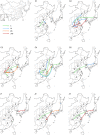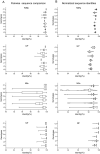Novel SFTSV Phylogeny Reveals New Reassortment Events and Migration Routes
- PMID: 32960400
- PMCID: PMC8087752
- DOI: 10.1007/s12250-020-00289-0
Novel SFTSV Phylogeny Reveals New Reassortment Events and Migration Routes
Abstract
Severe fever with thrombocytopenia syndrome virus (SFTSV), the causative agent of a febrile human disease, was first identified from central and eastern provinces in China, and later in Japan and South Korea. Hubei Province is one of the major SFTS epidemic areas in the central part of China. This study reported the isolation of 11 new SFTSV strains from patients in Hubei Province collected in 2017. Extensive phylogenetic analyses were conducted based on the complete coding sequences of SFTSV segments including the new strains. It was suggested that five different SFTSV genotypes were circulating in Hubei, and 15 reassortment patterns and migration pathways correlated with each genotype were identified, which was more than previously recognized. Hubei Province was more involved in the evolutionary events of SFTSV than that previously thought in which the evolutionary events of SFTSV were reported to be independent from those in other epidemic regions. Further divergence of SFTSV strains was suggested by pairwise comparison of SFTSV sequences from each genotype and sequence identity normalized to representative strain in genotype C1. Subsequently, amino acid variations specific for genotype(s), strain(s), or cluster(s) were inspected, which may be related to differential biological activity of SFTSV strains/genotypes. In conclusion, we analyzed the current status of SFTSV phylogeny in Hubei Province and discussed the possible events correlated to SFTSV evolution. It provided an in-depth insight into SFTSV evolution, raising concerns for the use of proper SFTSV strains in future studies.
Keywords: Amino acid variations; Genomic reassortment; Genotypes; Severe fever with thrombocytopenia syndrome virus (SFTSV); Virus migration.
Conflict of interest statement
The authors declare that they no conflict of interest.
Figures





Similar articles
-
Extensive genetic diversity of severe fever with thrombocytopenia syndrome virus circulating in Hubei Province, China, 2018-2022.PLoS Negl Trop Dis. 2023 Sep 18;17(9):e0011654. doi: 10.1371/journal.pntd.0011654. eCollection 2023 Sep. PLoS Negl Trop Dis. 2023. PMID: 37721962 Free PMC article.
-
Isolation, characterization, and phylogenic analysis of three new severe fever with thrombocytopenia syndrome bunyavirus strains derived from Hubei Province, China.Virol Sin. 2017 Feb;32(1):89-96. doi: 10.1007/s12250-017-3953-3. Epub 2017 Feb 24. Virol Sin. 2017. PMID: 28251516 Free PMC article.
-
Laboratory detection and molecular phylogenetic analysis of severe fever with thrombocytopenia syndrome virus in Hubei Province, central China.Arch Virol. 2018 Dec;163(12):3243-3254. doi: 10.1007/s00705-018-3993-5. Epub 2018 Aug 22. Arch Virol. 2018. PMID: 30136250
-
[Severe fever with thrombocytopenia syndrome: epidemiology, pathophysiology, and development of specific treatment and prevention measures].Rinsho Ketsueki. 2018;59(10):2255-2259. doi: 10.11406/rinketsu.59.2255. Rinsho Ketsueki. 2018. PMID: 30305533 Review. Japanese.
-
Pathophysiology of severe fever with thrombocytopenia syndrome and development of specific antiviral therapy.J Infect Chemother. 2018 Oct;24(10):773-781. doi: 10.1016/j.jiac.2018.07.009. Epub 2018 Aug 8. J Infect Chemother. 2018. PMID: 30098914 Review.
Cited by
-
Emerging Tick-Borne Dabie bandavirus: Virology, Epidemiology, and Prevention.Microorganisms. 2023 Sep 13;11(9):2309. doi: 10.3390/microorganisms11092309. Microorganisms. 2023. PMID: 37764153 Free PMC article. Review.
-
Extensive genetic diversity of severe fever with thrombocytopenia syndrome virus circulating in Hubei Province, China, 2018-2022.PLoS Negl Trop Dis. 2023 Sep 18;17(9):e0011654. doi: 10.1371/journal.pntd.0011654. eCollection 2023 Sep. PLoS Negl Trop Dis. 2023. PMID: 37721962 Free PMC article.
-
The public health threat of emerging phenuiviruses.One Health. 2025 May 6;20:101055. doi: 10.1016/j.onehlt.2025.101055. eCollection 2025 Jun. One Health. 2025. PMID: 40630111 Free PMC article. Review.
-
Metatranscriptomics Reveals the Diversity of the Tick Virome in Northwest China.Microbiol Spectr. 2022 Oct 26;10(5):e0111522. doi: 10.1128/spectrum.01115-22. Epub 2022 Oct 10. Microbiol Spectr. 2022. PMID: 36214702 Free PMC article.
-
Molecular mechanism and structure-guided humanization of a broadly neutralizing antibody against SFTSV.PLoS Pathog. 2024 Sep 25;20(9):e1012550. doi: 10.1371/journal.ppat.1012550. eCollection 2024 Sep. PLoS Pathog. 2024. PMID: 39321193 Free PMC article.
References
-
- Kim K, Kim J, Ko M, Chun J, Kim H, Kim S, Min J, Park W, Oh M, Chung J. An anti-Gn glycoprotein antibody from a convalescent patient potently inhibits the infection of severe fever with thrombocytopenia syndrome virus. PLoS Pathog. 2019;15:e1007375. doi: 10.1371/journal.ppat.1007375. - DOI - PMC - PubMed
MeSH terms
LinkOut - more resources
Full Text Sources

